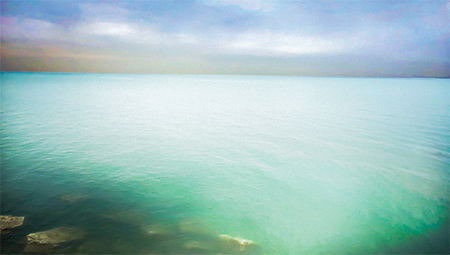If you drive by or stroll along the lakefront on the Evanston campus on a regular basis, you might have noticed that the color of Lake Michigan has been changing the past few years. While most of the time the water is a familiar slate blue-gray or brown-green color, there are days when it turns a Caribbean blue, almost turquoise. The photo of the Lake Michigan shore in Evanston below captures this strange tropical hue — it was taken in April. The image also shows that the water is so clear you can see the rocks beneath the surface. Surprisingly, Lake Michigan and Lake Huron recently surpassed Lake Superior in water clarity.

The Lake Michigan shore in April. Photograph by Michael Goss.
While that might sound like progress in cleaning up the Great Lakes, it’s not. The reason the water is so clear has to do with an invasion of zebra and quagga mussels that began more than 30 years ago — when mollusks stowed away on cargo ships from the Black Sea and were dispersed in the Great Lakes when the ships emptied their ballast water. The mussels, estimated to number in the hundreds of trillions in Lake Michigan alone, eat 90% of the lake’s phytoplankton, wiping out a critical food source at the bottom of the food chain — leaving the water crystal clear and devoid of food organisms for fish populations.
The mussels are just the latest in a large number of events that have taken a toll on the Great Lakes. Industrial pollution, agricultural runoff, increased algae blooms and recent severe flooding associated with changing weather patterns have led to more bacteria in the lakes — and lower quality of drinking water for the millions of people who depend on this freshwater source.

Stephanie Russell, executive editor of Northwestern Magazine. Illustration by Anje Jager
In March more than a dozen leading scientists and experts from Midwestern and Canadian universities and research institutions, including Northwestern civil and environmental engineering professor Aaron Packman, released a report on how climate change could further affect the Great Lakes and threaten public health, infrastructure, fish and wildlife, and the regional economy.
Packman, an expert in water scarcity, water management and urban flooding, is director of the Northwestern Center for Water Research, which coordinates water research across Northwestern and provides faculty and students with opportunities for multidisciplinary collaboration.
In our cover story, “Solutions for Troubled Waters,” you’ll read about Northwestern faculty, students and alumni from a variety of disciplines — chemistry, environmental law, engineering, anthropology and public policy — who are finding innovative and cost-effective ways to keep water systems clean and sustainable in this country and around the globe.
These outstanding leaders give us hope that we can indeed solve one of the world’s most pressing challenges — making clean water available to all.
Stephanie Russell
Executive Editor



Reader Responses
What pleasure to see the magazine these days. Congratulations for the summer 2019 issue. It is far more interesting, intelligent, informative and useful and than most past issues. The photographs were similarly of fine quality. I've been showing it off to friends. It synthesizes the creativity I lived with during my Northwestern years.
—Judith Harris '61, Trevignano Romano, Italy, via Northwestern Magazine
No one has commented on this page yet.
Submit a Response